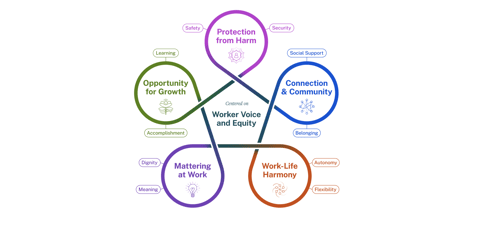Loud and Clear: the Message Behind Quiet Quitting

It's all about supporting mental health.
The silence is deafening. The term "quiet quitting" has been one of the top trending phrases of 2022. For those less familiar with the expression, it refers to the phenomenon of employees ceasing to go above and beyond in their professional role. Instead, workers are opting to pull back and setting limitations on the amount of time and energy they're willing to devote to the job.
As opposed to weekend warriors and those who subscribe to the hustle culture (where nothing is ever good enough), quiet quitters no longer work evenings and weekends. They don't check their email after EOD. And they certainly won't be vying for the next big promotion. No, quiet quitting involves doing the bare minimum to get the job done. But what's at the heart of the movement? Let's read between the lines.
In the United States, as many as 47 million people quit their jobs in 2021, but experts speculate that an even greater number are quiet quitting. In fact, Gallup estimates that 50% of the U.S. workforce - yes, half - is stepping back from the culture of overwork. A huge percentage of the workforce seems to be taking steps to reclaim their time, mental health, and overall wellbeing. And while this is usually framed as something to be avoided at all costs, is it really such a bad thing? If employees are still meeting job requirements, is there a problem?
The Surprising Employee Benefits of Quiet Quitting
At first glance, it could seem that quiet quitting is an indicator of a disengaged workforce with low productivity. But what if there were another side to it? Quiet quitting is a sign of what could be seen as a positive change: improved mental health. Employees who stop working above and beyond their pay grade may be spending more time doing the things that corporate wellness programs have been encouraging all along: spending more time with family, actually using their PTO, getting adequate rest, taking time to go to the doctor for routine check ups and screenings, managing stress, exercising and taking time to prepare healthy, nutritious meals. As decades of research has shown, these practices can all lead to a more productive workforce.
Soon after the COVID-19 pandemic faded, employees started wanting a more balanced workplace culture, and specifically started expecting mental health support as a standard employee benefit. Something had to give; burnout and anxiety due to the distressing global events of the last few years was unsustainable. Employees who had navigated health scares, shut downs, quarantine, and potentially a sudden shift to working remotely, and more, were exhausted. Overwork was no longer a feasible option.
Putting a Positive Spin on Quiet Quitting
Fears that quality of work will decline or that productivity will decrease due to employees taking a more balanced approach to work may be legitimate. But there can also be positive repercussions from a workforce taking a step back and reexamining their priorities. Workers want to be paid for the work they do - to 'act their wage' so to speak. If they go above and beyond, they expect a promotion that reflects and rewards that extra effort.
The trend is also a sign that employees are putting more value on mental and emotional well-being. Employers and leaders can lean into that sentiment by offering resources and programming to support a healthy workplace culture. Promoting a culture of employee mental health at work is one of the top priorities of those interviewing for new jobs, especially within younger generations. Not only can it help attract and maintain top talent, but offering mental well-being programming can increase overall health and can even lower costs associated with employee wellness.
Boosting Employee Mental Well-Being
Since job stress is a stronger predictor of overall health complaints than personal, financial, or family problems, prioritizing mental health can result in across-the-board improvements for the employer and the employee. In addition to affecting the wellbeing of employees, stressful jobs can cause elevated healthcare costs, lost productivity, and unwanted employee turnover. Sometimes elevated job stress is caused by temporary conditions, like new management, open enrollment, systems conversions, or busy seasons, but if a highly stressful work environment is a chronic problem, it can cause lasting fiscal and personnel problems. This scenario played out repeatedly during and post-pandemic, leading to one of the highest annual resignation rates in recent memory.
Mental wellbeing in the workplace matters, and employees are beginning to expect - if not demand - support. It can affect the lives of employees and their families, productivity, profits, and overall success of your organization. With accessible mental health resources and research-backed reasons to promote it, it’s easy to get started.
it turns out that quiet quitting was never the problem. Long work hours, unpaid extra responsibilities, and the stress of unpredictable global events led to burnout. Now employees are prioritizing a healthier, more balanced approach to work - one that includes time to rest and recharge, take care of their health, and show up as their best selves. That sounds like employee well-being at its finest.
If you're looking to incorporate employee mental well-being into your workplace contact us to take get started.



